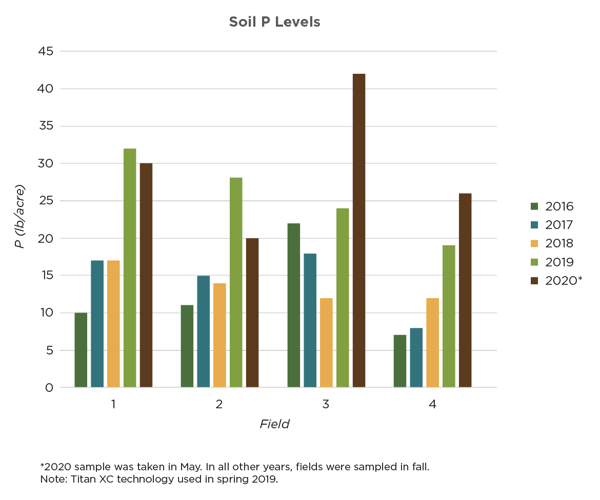Since its introduction in Canada several years ago, TITAN XC technology for dry fertilizer (sold as Atlas XC) has established a reputation for strengthening yield performance when added to a grower's dry fertilizer practice. Similar to the United States, Nutrien Ag Solutions agronomists there have also measured an increase in soil phosphorus levels when this biocatalyst technology is used to enhance nutrient release from dry fertilizers.
In the Canadian Prairie, Nutrien Ag Solutions' Southeast Saskatchewan Division has performed five years of soil tests to evaluate soil phosphorus levels in four fields belonging to a grower customer. With the help of the Echelon soil sampling app, all cores were taken within 10 feet of the same location each year. Sampling was done in the fall after harvest except in 2020, when samples were taken in May.
Sampling revealed that phosphorus deficiency was a major problem in the fields prior to the grower adopting TITAN XC technology on his dry fertilizer. Candice Robinson, Manager of Agronomy Services for the Division, shares that 75.6% of the roughly 26,500 acres sampled in 2018 showed phosphorus deficiency (<25 lb P/acre). Of those deficient acres, 36.7% were critically deficient (<10 lb P/acre).
In spring 2019, the grower used his standard dry fertilizer (50lb/acre of 11-52-0) treated with TITAN XC technology on all of the fields. The subsequent fall 2019 soil tests showed a considerable increase in phosphorus levels compared to pre-Titan XC levels, as did the spring 2020 test.

"When soil phosphorus levels are critically low, there is no rapid remedy. Phosphorus is easily tied up in the soil, which makes building phosphorus reserves a slow process," says Candice.
Using a higher rate of phosphorus-based fertilizers isn't necessarily the answer, given the inefficiency of phosphate applications in the first year after application, as well as the risk for seedling injury.
"Growers can only apply a certain amount of MAP fertilizer before salt injury occurs to seedling plants," Candice adds.
But, as these soil tests show, using TITAN XC technology to increase phosphorus availability from dry fertilizers can help growers more quickly build soil levels of phosphorus, without the risks and investment associated with simply applying higher rates of phosphate fertilizer.
Learn more about TITAN XC by visiting the TITAN XC hub.






